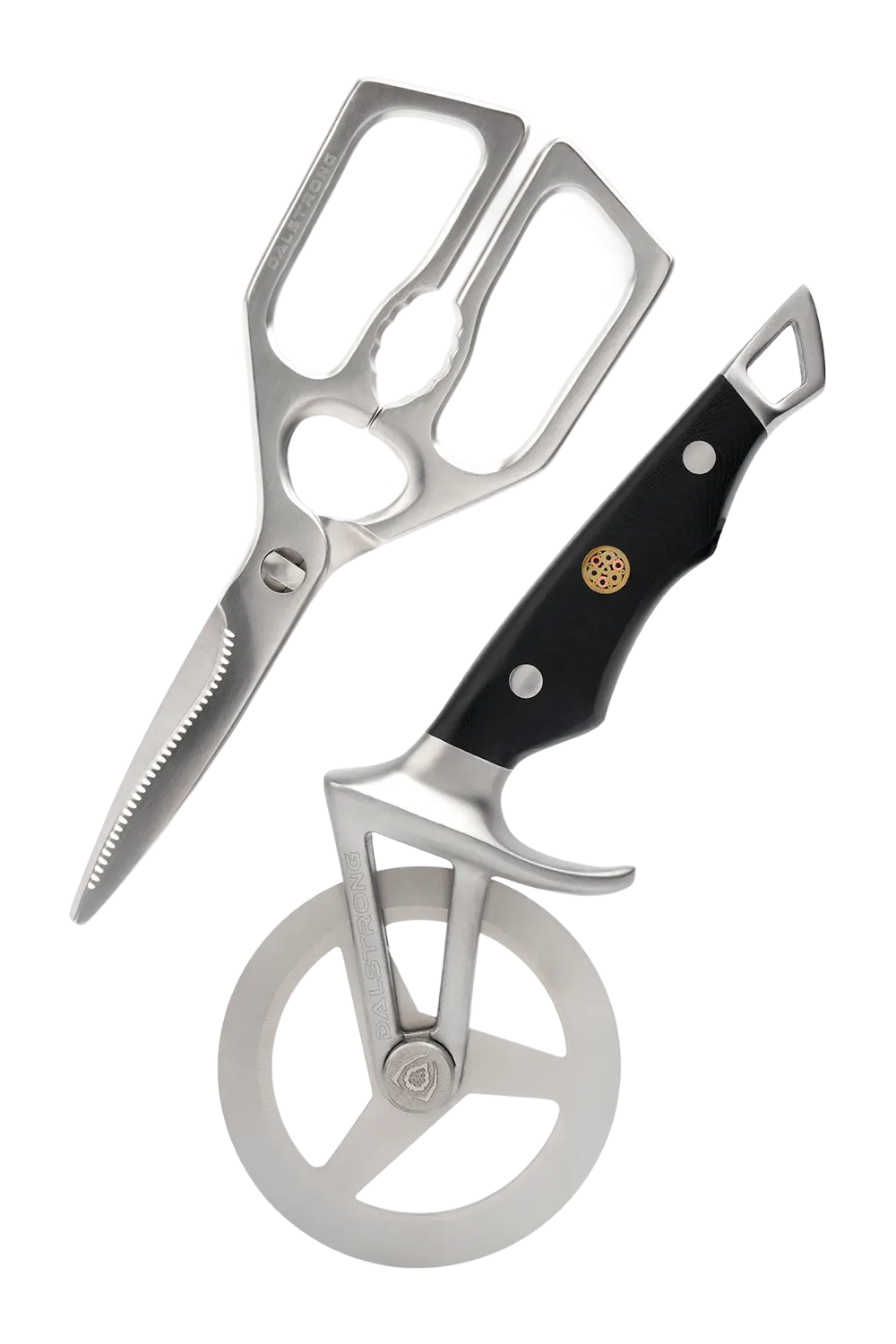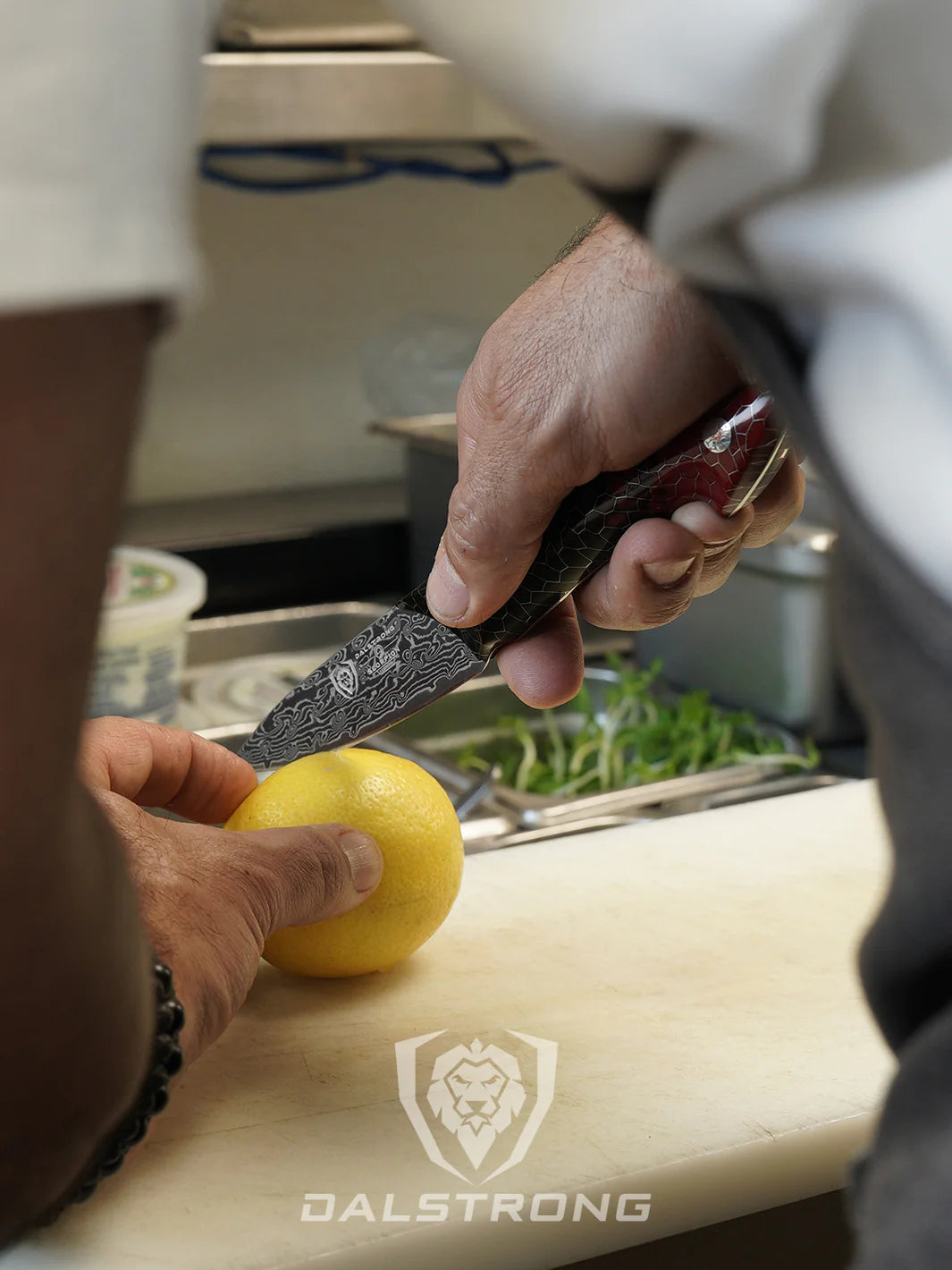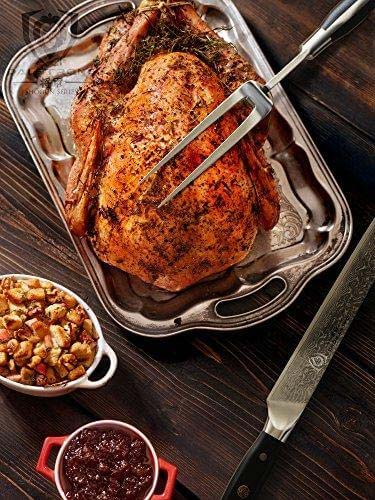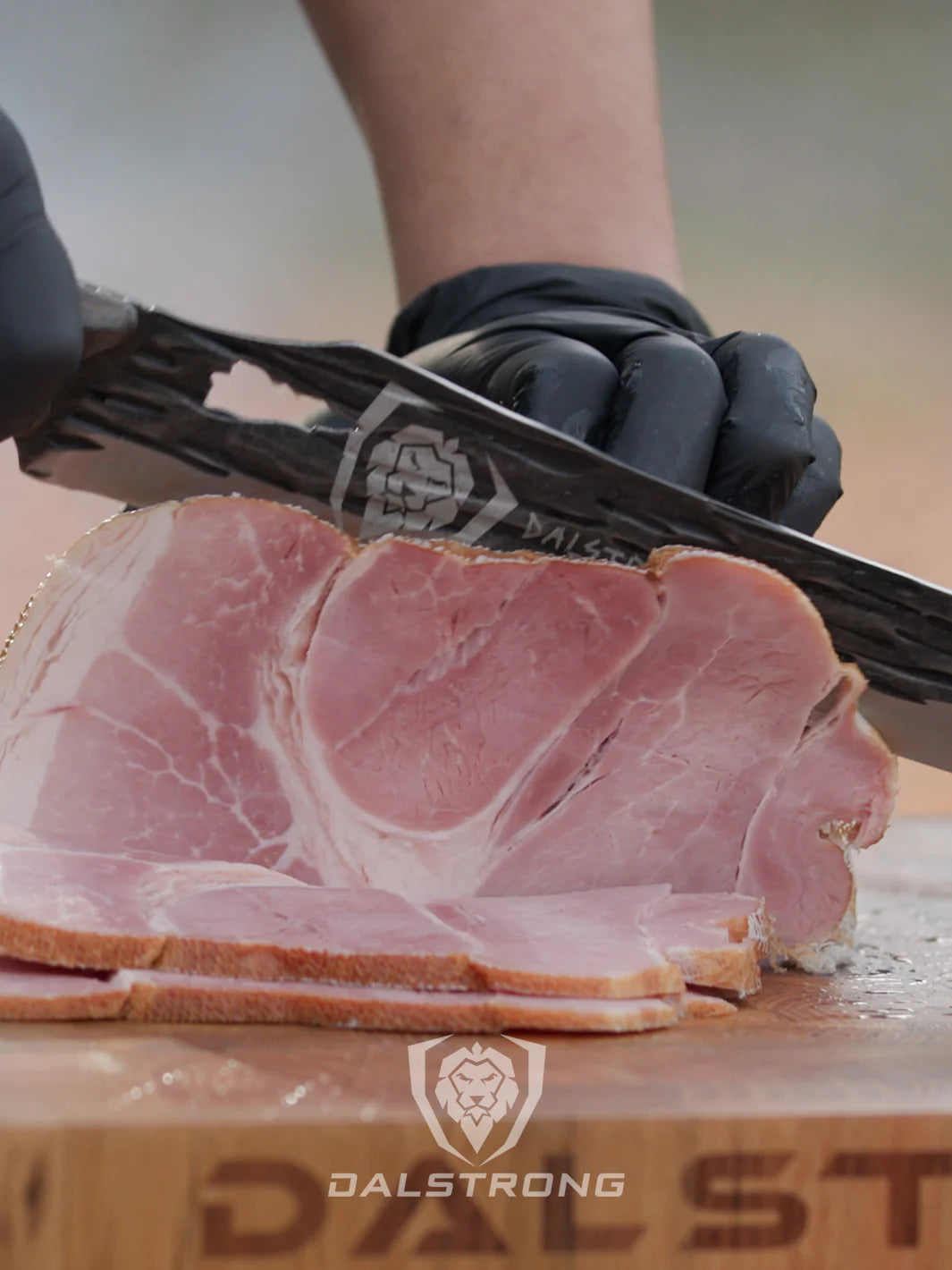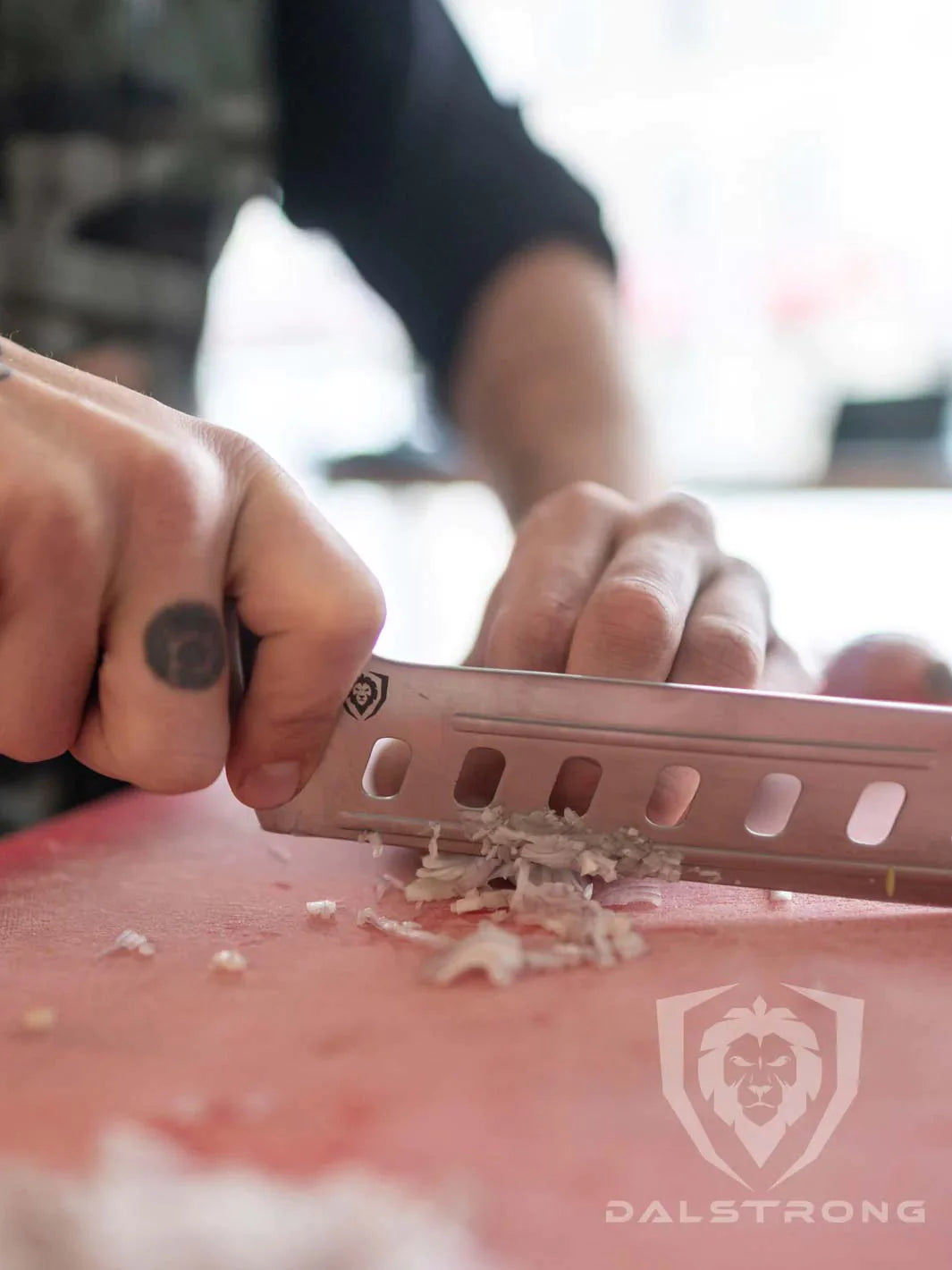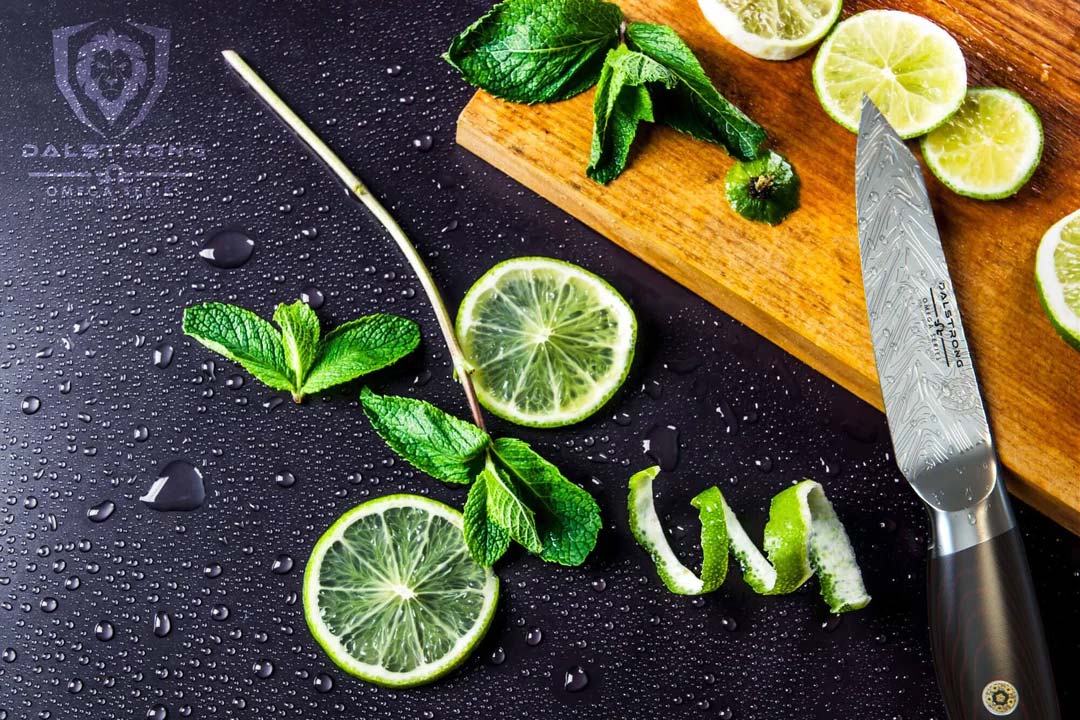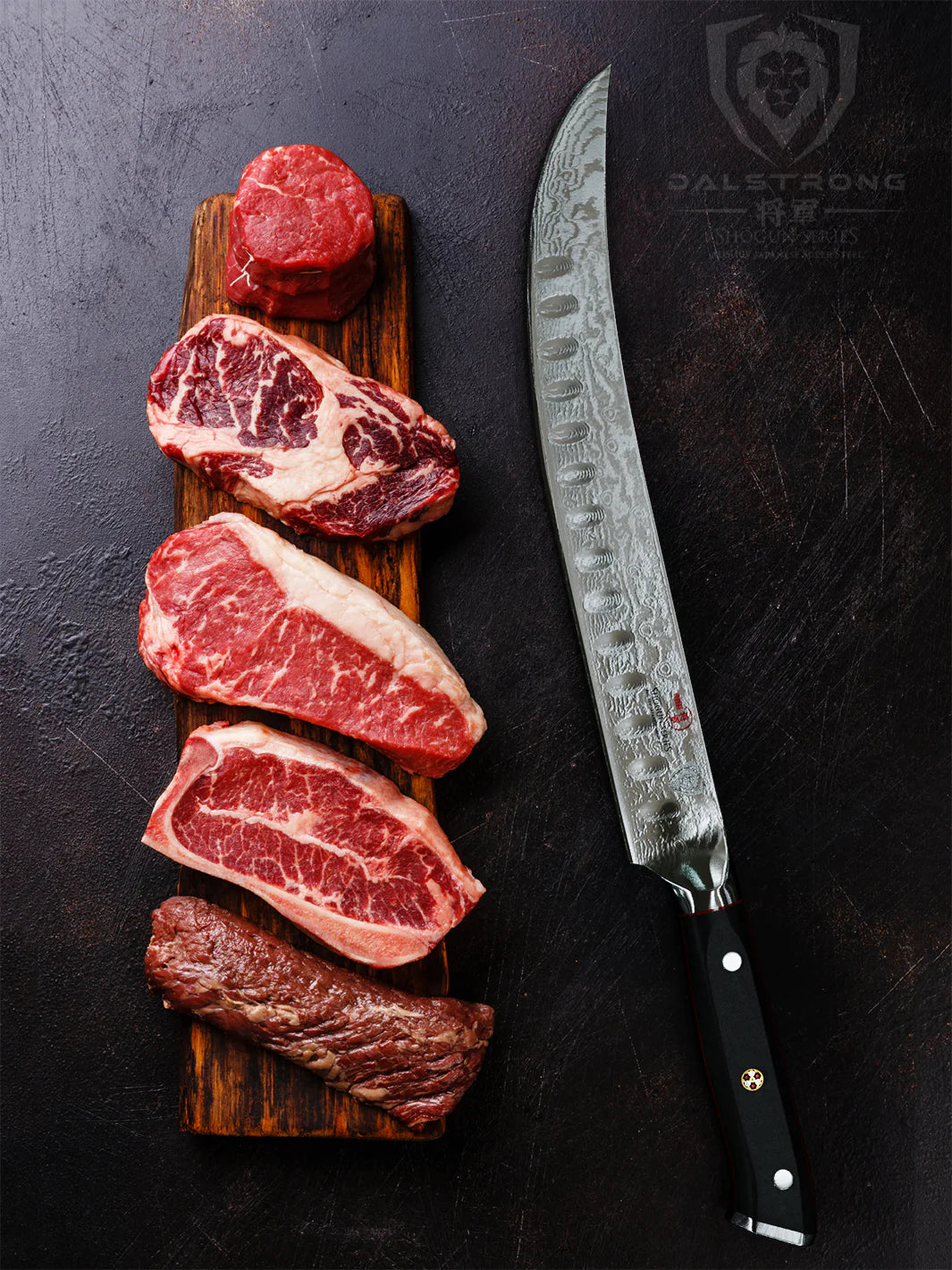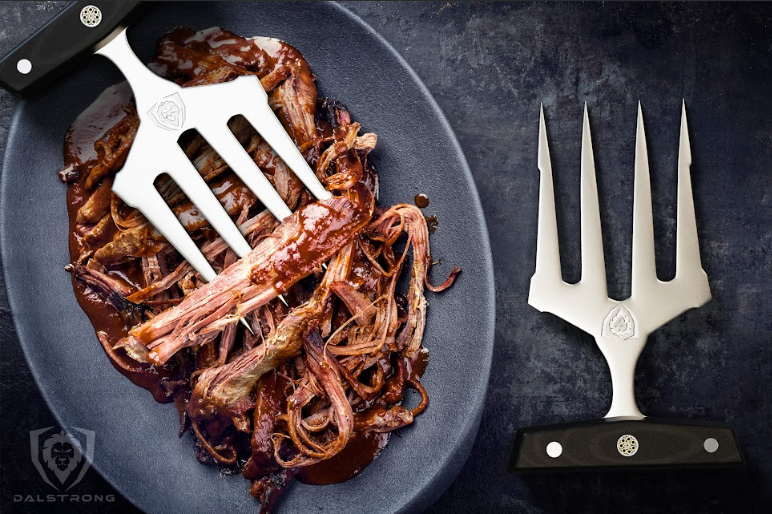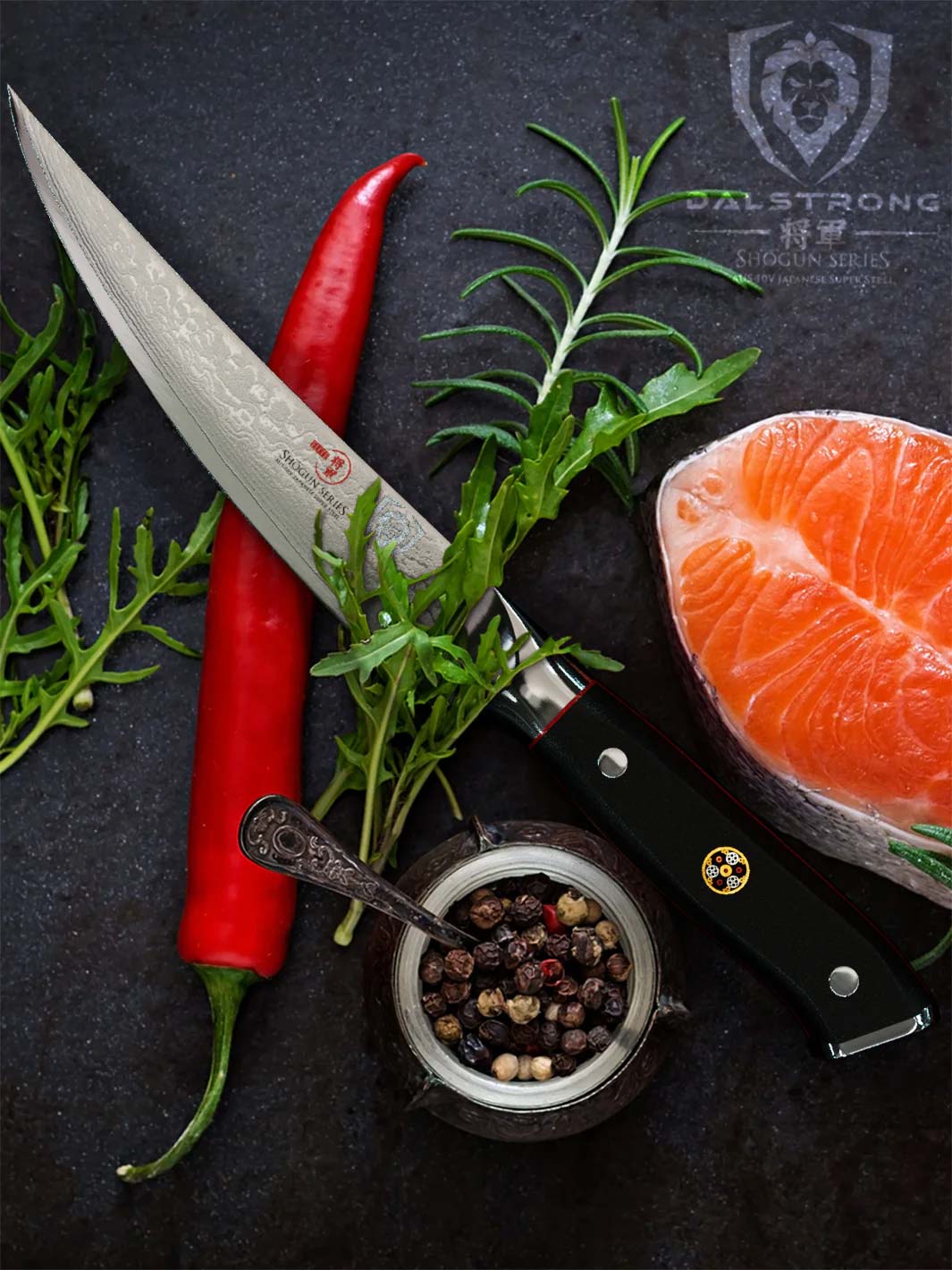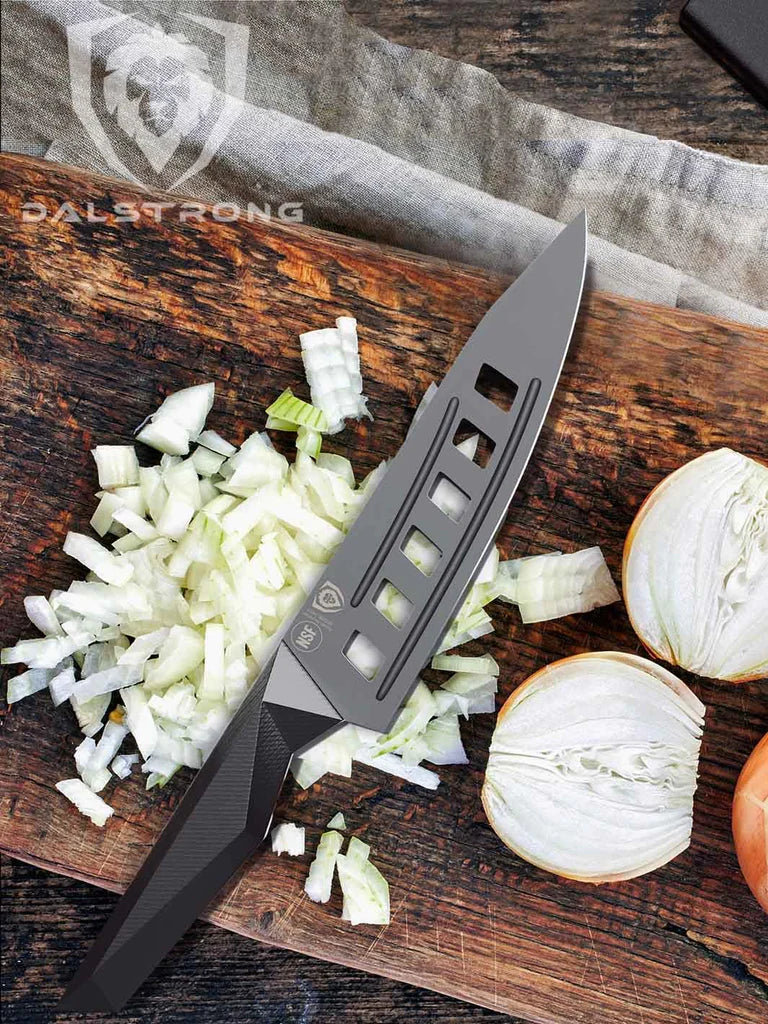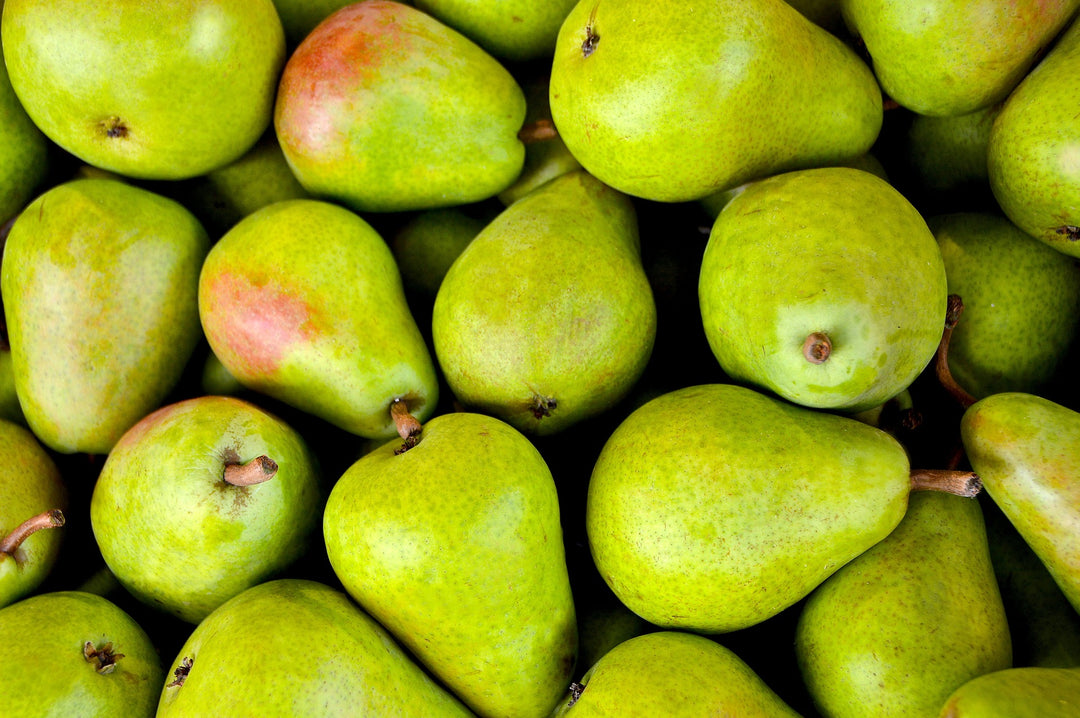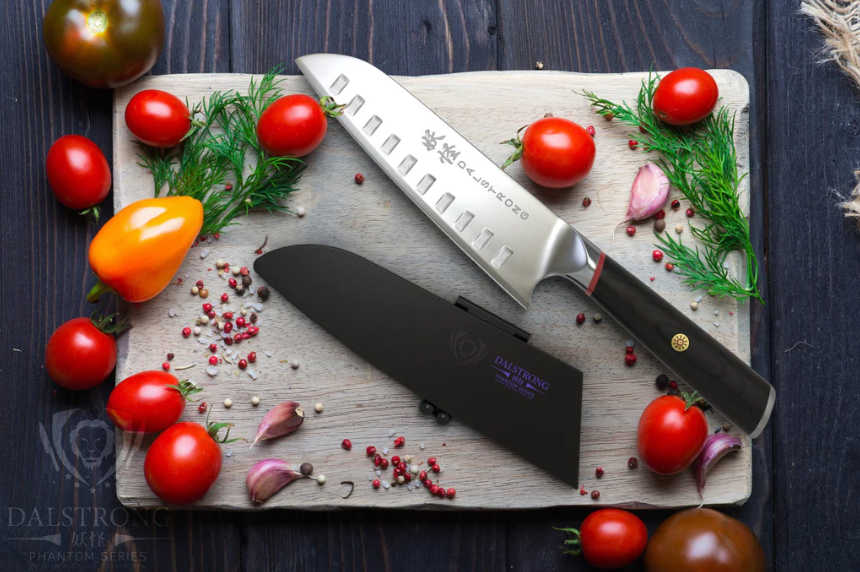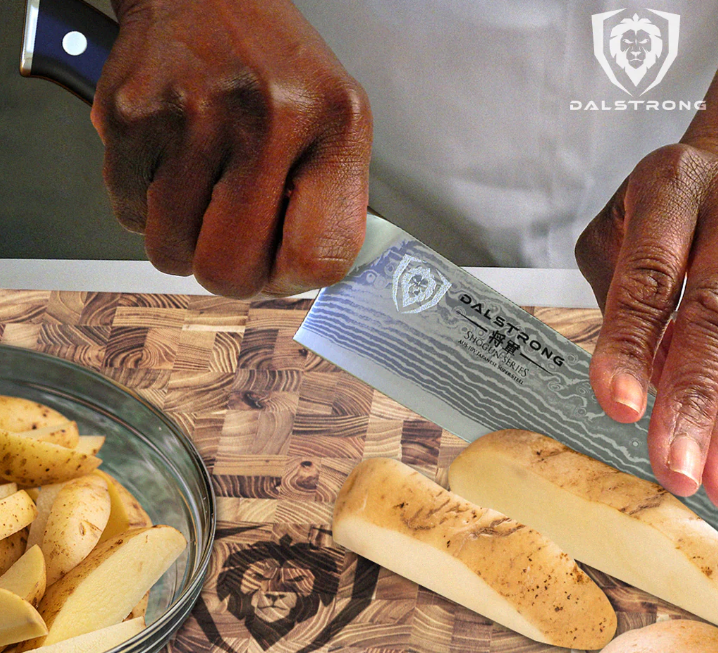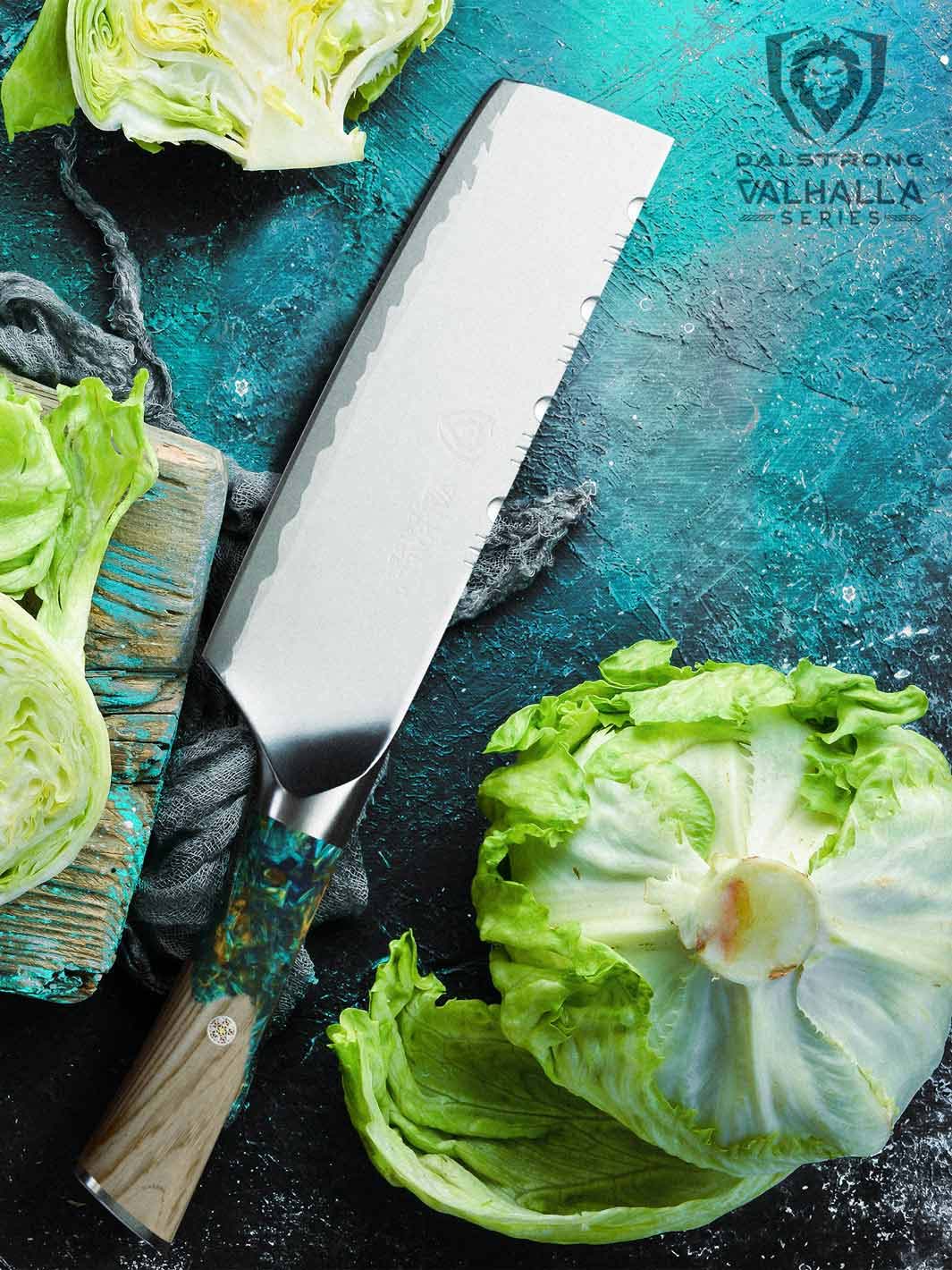Easy Guide On How To Cut A Bell Pepper
 Paring Knife 4" Delta Wolf Series | Dalstrong ©
Paring Knife 4" Delta Wolf Series | Dalstrong ©
Quick Overview: How to Cut A Bell Pepper
- Place the ripened bell pepper on a cutting board.
- Use your knife skills and remove the top stem.
- Remove the white pith or core with the knife.
- Halve the vegetable and trim the pepper skin as per your liking.
- Use a knife to clean the inside of the pepper, also known as the walls.
- Lay the pepper halves back on the chopping board and cut as per your cooking needs.
While there are incredible recipes out there to be tried, such as cooking bell peppers in an instant pot or air fryer, you need one thing down – your peppers should be well-chopped. In this blog, I’ll be walking you through the different methods by which you can slice and dice bell peppers with ease.
1. How To Choose The Best Bell Peppers
 7'' Nakiri Knife | Crusader Series | Dalstrong ©
7'' Nakiri Knife | Crusader Series | Dalstrong ©
Before I walk you through the different methods by which you cut bell peppers, here’s a little insight into how you choose the best ones. When shopping for fresh bell peppers (read about the nutritional benefits of bell peppers here), you want to feel the tightness in your hand. The pepper skin should be firm to the touch and vibrant in its appearance.
Look for soft spots around the bell pepper. Usually, there are soft spots around the top step or just around the top of the peppers. Inspect the top and bottom well before you add them to your cart.
Keep in mind, the pepper shouldn’t be rock solid to the touch, as this would indicate that it is not yet ripe. If you can, select bell peppers that have bumps on the bottom. If the bottom of the pepper is brown or moist, it’s best to avoid it.
To sum it all up, select bell peppers that are firm to the touch, and vibrant in color. Now, you’re probably wondering how to cut peppers. So, let’s get right into it.
2. How To Cut A Bell Pepper
 Nakiri Vegetable Knife 7" Shadow Black Series | NSF Certified | Dalstrong ©
Nakiri Vegetable Knife 7" Shadow Black Series | NSF Certified | Dalstrong ©
There are many methods by which you can cut bell peppers. Here are the four most popular and common ones with a step by step guide.
How To Julienne Peppers
- Start by placing a damp paper towel under your cutting board.
- Laying the bell pepper on its side and removing the top step with a chef’s knife.
- Use a knife to cut through the top stem away from the core.
- When the top of the peppers is separated from the top of the core, remove the core, otherwise known as the white pith.
- Place the pepper back up, and halve it into two. You should now have the top and bottom of the pepper without the white pith.
- Using a paring knife, slide the knife on the inside of the pepper.
- You can then lay the pepper flat on your cutting board and julienne the pepper into thin strips (4-5 cm long is ideal).
- You should now have even and thin slices of pepper for fajitas and tacos.
How To Dice Bell Peppers
- Once the core/white pith of the pepper is removed, lay the pepper flat on your cutting board.
- Use a sharp knife and start cutting into strips.
- Clean the inside of the peppers if you see seeds stuck to the walls.
- Lastly, slice and dice the strips by bunching them together.
- Continue cutting perpendicular with a paring knife and you should have diced peppers on your chopping board.
How To Cut Peppers Into Rings
- Once the core is out of the pepper, slice peppers from the top and bottom.
- Then, lay the pepper on its side and make cross-sections on each side.
- This should leave you with even and uniform pepper rings that can be used for a stir fry.
How To Mold A Stuffed Pepper
- Start by removing the top of the pepper, also known as the top stem.
- Once you extract the core, use a paring or chef’s knife to clean the wall or inside of the pepper.
- Once all the seeds are out, you can trim the pepper skin and stuff the filling of your choice into it.
- There you have it, stuffed peppers are ready to be cooked.
Kitchen Tips:
- Remove the core from the top of the peppers by outlining the top portion and divide and continue to chop.
- You can julienne or dice the pepper if you wish to cook them in an instant pot or air fryer.
Storage Tips:
- Store the peppers in airtight containers on a sheet of paper towel to have the vegetable last longer than usual.
3. Essential Tools You Will Need
1. Teak Cutting Board Large Size | Horizontal Grain
When working with uneven vegetables like bell peppers, you need a sturdy and resilient cutting board at all times. This Teak wood chopping board has a beautiful horizontal grain that is striking to look at, and ten folds comfortable and ergonomic to work with. Not only is it ideal for home cooks and professional chefs, but it’s also fantastic for the novice learning and mastering knife skills.
PROS:
- The size of this chopping board is ideal for both, large and compact kitchens.
- The design and structure of this Teak board make it versatile – You can use it as a charcuterie board or a chopping block.
- The wood is sustainably sourced and is instilled with natural oils.
CONS:
- At Dalstrong, we believe that there are no limits, so if you want to try your hand at something more daring instead, check out this Wood Fibre Cutting Board.
- Are you looking for a chopping board that can also be used as a serving tray? This may not be the one for you, but keep reading, we’ve got you covered.
2. Dalstrong Series Infinity Series Wood- Fibre Cutting Board - Large - Obsidian Black
Did someone say “fancy yet functional”? this wood fibre cutting board is one for the books. Made with environmentally friendly wood fiber, this chopping board can take on razor-sharp knives. The G10 serving handle is ergonomic and comfortable to hold.
PROS:
- Equipped with non-slip silicone feet for safe chopping and slicing.
- Easy to clean and even easier to store.
- This board may be lighter in weight compared to Teak wood boards, but it’s commendable how durable it is.
CONS:
- If like me, you too prefer a classic approach to the culinary world, then a Teak wood cutting board may better suit your needs.
- You could be on the lookout for a smaller chopping board.
- This board requires maintenance from time to time, so if you’re a busy bee, this is something to remember.
3. Vegetable Knife 8" The Deflector - Gladiator Series
This vegetable knife is truly a deflector, as it glides and slides through the most stubborn cuts of vegetables. This knife has precision, speed, and a full tang blade for balance, sturdiness, and dexterity. The blade on this knife is hardened at 56+ Rockwell.
PROS:
- This knife is a win for all home cooks as it has the perfect blade length to take on most vegetables.
- Improved knuckle clearance to quicken meal prep.
- Ultra-sharp blade with a polished edge.
CONS:
- If you work with small to medium-sized vegetables, the blade on this knife could be a little intimidating to work with.
- If you prefer working with a versatile chef’s knife or a paring knife, that’s perfectly alright. It all comes down to preference.
4. Chef's Knife 6" - Gladiator Series
The blade on this knife is of ultra-premium, high-carbon German Thyssen Krupp steel. Hardened at 56+ Rockwell for a robust finish.
PROS:
- One of Dalstrong’s best-selling knives, so you don’t have to worry about the performance.
- The wide blade on this knife gives you plenty of knuckle clearance.
- The perfect knife for seasoned chefs and home cooks.
CONS:
- If you want something a little more ‘blade’, an 8-inch or 10-inch knife might better suit your needs.
- While this knife is low in maintenance, you may want something heavy-duty to polish your knife skills.
5. Paring Knife 3.5" - Frost Fire Series
Who doesn’t love an icy-cold-looking knife? This paring knife has the perfect blade length to cut bell peppers as per your preference. Made with 7 layers of high-carbon steel.
PROS:
- Premium quality 10CR15MOV steel.
- The added amounts of cobalt and expert heat treatment make this knife extremely robust and durable.
- Sharpened at 16-18º on each side for tremendous edge retention.
CONS:
- If you prefer a traditional-looking knife, this may not be the one for you.
- You may want to work with a longer blade for larger vegetables.
4. Frequently Asked Questions
What is the best way to cut a bell pepper?
The best way to cut a bell pepper is by using a paring knife or a chef’s knife. This keeps the inside of the pepper clean from seeds and stuck-on particles of the core.
How do you cut bell peppers step by step?
Place your bell pepper on a sturdy cutting board and use a sharp knife to remove the top stem. Then, proceed to remove the core and clean the walls on the inside with a paring or chef’s knife. Lay the pepper back on the chopping board and choose the style of cutting. (Julienne, dicing, slicing, strips, and rings)
How do you cut bell peppers into strips?
Use a paring knife to cut the peppers into strips. Start by laying the vegetable flat on a chopping board. Then, make the first incision on the pepper and continue to keep the same length and width on each strip. Ideally, this should be 4-5 cm long).






















































































































